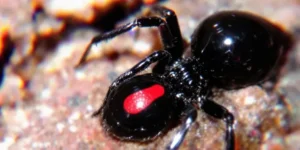Are you concerned about venomous spiders in your home? The redback spider female is one of Australia’s most feared arachnids. This blog post will teach you how to identify and avoid these dangerous creatures.
Learn about the redback spider female and stay safe!
Key Takeaways
- Female redback spiders have a black body with a red stripe and can be as small as 10 mm long.
- These spiders live all over Australia and have spread to other countries like Japan and the UAE.
- Redback spider bites can cause severe pain, sweating, and nausea in humans.
- About 2,000 to 10,000 people get bitten by redbacks each year in Australia, with 250 needing antivenom.
- Female redbacks can store sperm for up to two years and make 4 to 10 egg sacs, each with up to 500 eggs.

Physical Characteristics of Female Redback Spider

Now, let’s examine the appearance of female redback spiders. These spiders have a distinctive look that distinguishes them.
Female redback spiders are easily identifiable. They possess a round, black body with a vivid red stripe on top. Their underside features a red or orange hourglass-shaped mark. These spiders are quite small, measuring only about 10 mm in length, comparable to the size of a small paper clip.
Young female redbacks have a slightly different appearance. They begin with white markings that darken as they mature. Female redbacks typically live for 2 to 3 years. Throughout their lifespan, they undergo multiple moults to increase in size.
Distribution and Habitat
Redback spiders inhabit various regions across Australia. They thrive in urban areas such as Brisbane, Perth, and Alice Springs. These spiders typically conceal themselves in dry, secluded locations.
They may be found in firewood stacks, sheds, or even children’s outdoor playthings. They prefer to remain hidden and away from direct heat.
These spiders have expanded their range beyond Australia. They’ve established populations in Southeast Asia, New Zealand, and parts of the United States. Since the 1980s, ships have transported them to new locations.
Currently, redbacks can be observed in Japan, Belgium, and the UAE. Their ability to adapt to new environments contributes to their status as a potential pest in some areas. The following section will examine the behaviour and diet of these spiders.
Behaviour and Prey
Female redback spiders are nocturnal predators. They create irregular webs in secluded areas close to residences. These webs feature a funnel-shaped section where the spider conceals itself.
The web contains adhesive strands capable of ensnaring small lizards.
Redbacks consume insects, spiders, and small vertebrates. They encase their prey in silk and inject venom. This venom liquefies the prey’s internal organs. Male spiders and spiderlings frequently inhabit the periphery of the female’s web.
They consume the remnants of her meals.
Reproduction and Life Cycle
Female redback spiders have a distinctive reproductive method. They can store sperm for up to two years in specialised structures called spermathecae. This allows them to produce egg sacs even in the absence of males.
Each female can create 4 to 10 egg sacs. These sacs are small, approximately 1 cm wide, yet contain numerous eggs. A single sac can house 40 to 500 eggs, with the average being about 250.
Spiderlings hatch after approximately 8 days. In colder conditions, this process may take longer. The mating process poses significant risks for male redbacks. They perform a somersault during mating, which frequently results in the female consuming them.
This makes it challenging for males to find mates. Fewer than 20% of male redbacks ever mate in their lifetime. This unusual mating behaviour contributes to the species’ survival, despite its detrimental effects on the males.
Venom and Its Effects on Humans
The female redback spider possesses venom that is highly toxic and can inflict intense pain in humans. Its bite may result in perspiration, queasiness, and emesis, necessitating prompt medical attention.
Venomous Nature of Redback Spiders and Its Effects on Humans
Redback spiders have potent venom. Their venom is primarily neurotoxic, causing a condition called latrodectism in humans. Each bite delivers about 0.08–0.10 mg of venom. This amount is sufficient to cause significant illness in people.
Bites from redbacks can cause intense pain, nausea, vomiting, headaches, and sweating. In Australia, these spiders bite 2,000–10,000 people annually. Approximately 250 cases require antivenom treatment.
Children, older adults, and individuals with compromised immune systems face a higher risk of severe reactions. Most bites occur during warmer months, often in late afternoon or evening.
Supplementary information on Redback Spiders
Redback spiders have many interesting aspects. Discover information about their bites, treatments, and the differences between males and females.
Common Symptoms of a Redback Spider Bite
Redback spider bites can cause severe pain and other symptoms. Here are the common signs to observe:
- Pain at the bite site: It starts mild but intensifies over time.
- Sweating: The bite area and nearby parts may perspire excessively.
- Nausea and vomiting: These often occur within an hour of the bite.
- Headache: A throbbing headache is typical after a bite.
- Muscle pain and weakness: This can affect the entire body.
- Stomach pain: Severe stomach cramps may develop.
- Chest or back pain: This can resemble a heart attack in some instances.
- Swollen lymph nodes: Nodes near the bite site may enlarge.
- Fever and chills: A mild fever often accompanies other symptoms.
- Leg pain: Bites on the trunk can result in leg pain.
- Crying in young children: Children under four may cry persistently if bitten.
- Rash in children: A rash may appear on young children after a bite.
- Neck spasms: Older children might experience neck muscle spasms.
- Bite marks: Two small puncture marks may be visible at the bite site.
- Swelling: The bite area may become slightly swollen.
Treatment Options and Antivenom
Redback spider bites require prompt action. Here are the key steps for treatment and antivenom use:
- Apply ice to the bite site immediately. This helps alleviate pain and slow venom spread.
- Seek medical attention promptly. Medical professionals can assess the severity of the bite and provide appropriate care.
- Antivenom has been available since 1956. Approximately 2-20% of bite victims receive it.
- Medical practitioners administer antivenom as an injection or through an intravenous drip for severe cases. There is some discussion about its effectiveness.
- The antivenom can cause side effects. These include rashes (5%), severe allergic reactions (1-2%), and serum sickness (10%).
- Avoid using pressure bandages. They are ineffective for redback bites and may exacerbate the situation.
- Pain management is a significant aspect of treatment. Medical professionals may administer strong analgesics to assist.
- Some individuals require hospitalisation. This allows medical staff to monitor for any adverse reactions.
- Follow-up care is essential. Patients should consult their doctor again to assess their recovery progress.
- Familiarise yourself with redback spider safety. This can help prevent bites from occurring initially.
Comparison Table: Female vs. Male Redback Spider
Redback spiders display notable differences between females and males. This table highlights key contrasts in their size, appearance, and impact:
| Feature | Female Redback Spider | Male Redback Spider |
|---|---|---|
| Body Length | ~10 mm (0.4 in) | 3-4 mm (0.12-0.16 in) |
| Colour | Black body with red markings | Light brown with white markings |
| Shape | Spherical | Elongated |
| Lifespan | 2-3 years | 6-7 months |
| Bite Impact | Medically significant | Mild pain, rare |
These differences influence how each sex behaves and affects humans. Females present a greater risk due to their size and venom potency. Males, being smaller, are less likely to bite or cause harm. Recognising these traits aids in identifying and avoiding potential dangers from redback spiders.
Redback Spider: The Essential Australian Guide
Discover the truth about the redback spider in Australian environments.
This blog post is worth reading because it covers everything from its spider web habits to its link with pest control concerns, ensuring you stay informed about this fascinating arachnid.
1. What Is a Redback Spider Female?
A red back spider is an Australian redback spider known for its distinctive red or orange stripe on the abdomen. It’s a species of spider in the same group as widow spiders—the black widow spider is a relative of the redback spider. A visible stripe on its back or stripe on the upper abdomen often appears on the adult female redback.
2. How Does the Redback Spider Female Work?
The spider web crafted by a red-back spider includes sticky strands to trap prey. Redback spiders are found near sheds, with each spider is found in corners or beneath objects where spiders are known to gather.
3. Does Redback Spider Female Venom Matter?
Yes. Spider venom from a female spider can be potent, particularly if a person is bitten by redback spiders. The redback spider is one that wields a red stripe on the upper abdomen, posing risk if the spider is disturbed.
4. What About a Redback Spider Female Bite?
A red back spider bite affects soft tissue around the bite, sometimes causing pain. The smaller male often carries less toxin, but caution remains essential.
5. Do Redback Spider Female Eat More Than Insects?
Indeed, redback spiders eat insects, and redback spiderlings sometimes display cannibalistic tendencies. Males can be male is functionally sterile, yet female in sexual cannibalism has been observed.
Comparison Table: Redback Facts
| Feature | Detail |
|---|---|
| Body with a Prominent Red | Often a stripe on the upper side |
| White Markings on the Upper | Sometimes on juveniles |
| Marking on the Underside | Can appear in the absence of a red dorsal |
| Trapdoor Spiders Difference | They build hidden burrows, not webs |
Key Points to Remember:
- The Redback Spider Female abdomen can be the size of a large pea.
- A black body with a prominent hue is typical.
- Redback venom can harm if a redback may feel threatened.
- Spiders like the funnel web spider differ in habitat and aggression.
Conclusion
Female redback spiders are formidable creatures in Australia. These small arachnids possess highly potent venom. Although bites can be alarming, appropriate medical care and treatment typically result in complete recovery.
Understanding these spiders helps us maintain safety and appreciate their ecological role. For additional information on redback spiders and other Australian wildlife, visit RedBackSpider.com.
FAQs
1. What’s the deal with female redback spiders?
Well, mate… these Aussie arachnids are pretty serious business. The sheila redbacks are the deadly ones – small, black, with a red stripe on their back. They’re famous for being more dangerous than their blokes.
2. Where might you spot these creepy crawlies?
These little beauties love dark, dry spots. You’ll find ’em in sheds, dunny seats, and even old shoes. They’re all over Australia, so keep your eyes peeled when you’re poking around outside.
3. How bad is a Redback Spider Female bite?
It’s no walk in the park, that’s for sure. A bite from a female redback can cause severe pain, sweating, nausea, and vomiting. It’s rare, but it can be fatal if not treated. If you cop a bite, get to a hospital quick smart.
4. Do Redback Spider Female always attack humans?
Nah, they’re not out to get ya. These spiders are pretty shy and only bite when they feel threatened. But if you accidentally disturb their web or squish ’em, they might give you a nip. Best to leave ’em be and call a pro if you need ’em moved.





